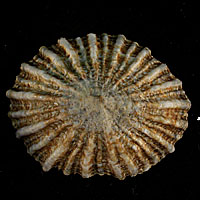|
< Previous family introduction |
|
|||||
|
|
Family Siphonariidae Siphon limpets
|
|||||
|
Siphonariidae are remarkable animals as they are amphibious, being capable of breathing air as well as water. They possess a “lung”, a vascularised structure evolved for the mantle cavity, totally enclosed apart from a small opening to the exterior, the pneumostome. When exposed to air, respiration is by the “lung” and the moist sides of the foot, but when submerged, respiration is taken over by a secondary gill within the mantle cavity (Wong, 1980). Siphonariids live over the whole range of the intertidal zone, with some even occurring above the high tide level. Some live among and feed on macroscopic algae at lower levels, but others live on apparently bare, dry rock, feeding on microscopic algae when wet by the incoming tide or spray. Many species return to a home scar when not feeding, the superior fit of which affords some protection from predators and wave forces. Siphonariids are hermaphrodite animals, with both male and female organs active in the one individual. Sperm is transferred during copulation, and fertilisation takes place internally, with a gelatinous egg mass being produced containing thousands of individuals. Some species attach the egg mass to rocks, from where planktotrophic larvae are released into the water after a few days, but in one NSW species which lives high on the shore, the egg mass is cast directly into the water, thus avoiding dessication. Four large and three small species occur in NSW, all of which are endemic to Australia. The identity of the species and their distributions were confused in both popular and scientific literature, with about 30 names in use, until Bruce Jenkins commenced publication of a revision of the family in Australia in 1988. Family Reference There is no modern consolidated reference to the family. The publications of Jenkins (1981, 1983, 2018) and of Quinn (1988a, 1988b) deal with the Australia species Coverage All the named species that occur in NSW are detailed here. Identification Notes The limpet shape has been adopted by numerous unrelated groups of molluscs including the common true limpets Acmaeidae and Patellidae, the deep water Lotiidae, the sugar limpets of the family Phenacolepadidae and the slit limpets of the Fissurellidae; on this web site, there are 15 families that have limpet-shaped shells. Some families have peculiar characteristics which enable species to be placed in the family, but others have little indication in the shells to indicate the family to which they belong; in that case placing shell specimens in the correct family is sometimes a matter of identifying the species first. Distinguishing features of the Siphonariidae family are the horseshoe-shaped muscle scar and the siphonal groove on the centre right of the shell. Of the 4 large species of the family found in NSW, typical non-eroded specimens are readily identified but worn or unusual shells may not be able to be identified at all. Shell height varies within each species, those exposed to strong wave action being lower than those from protected areas. Internal colouration varies widely and is of secondary importance in identification.
|
